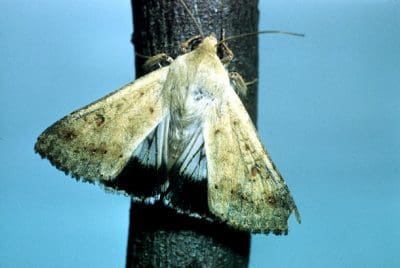GRAIN growers now have a strategy to target one of their most insecticide-resistant pests, Helicoverpa armigera, through a finely tuned combination of beneficial insects, selective insecticides and accurate spray methods.
The Grains Research Development Corporation (GRDC) investment into a National Insecticide Resistance Management working group has launched a new Resistance Management Strategy (RMS) to reduce the development of resistance across consecutive generations of H. armigera.
H. armigera, commonly known as heliothis, is a pest of many commodity crops including cotton, pulses, oilseeds, coarse grains and winter cereals, but causes more significant damage in summer and winter pulses, maize, sorghum, canola, linseed, safflower and sunflowers.
New South Wales Department of Primary Industries (DPI) lead researcher Dr Lisa Bird said the RMS developed was centred on the management of heliothis pests in the key pulse crops, chickpeas and mungbeans, in the northern grains region.
“Insecticide use in these crops is likely to have the greatest impact on the selection for resistance in H. armigera populations in the foreseeable future, but the principles of the RMS can be applied to other grain crops,” Dr Bird said.
“There is an urgent need to strategically manage the threat of resistance to maintain the efficacy of available insecticides.
“In the past we’ve seen devastating consequences from resistance due to overuse of broad-spectrum insecticides in the cotton industry. We don’t want to see the same situation repeated in grains.”
Selective insecticides for H. armigera control are now widely registered in grain crops.
The RMS is primarily built around product windows for two of the most widely used selective products, and indoxacarb and chlorantraniliprole, because:
- Indoxacarb (e.g. Steward) is at risk due to genetic predisposition (high level genetic dominance and metabolic mechanism) and pre-existing levels of resistance in NSW and Queensland. The use of indoxacarb in pulses is also expected to increase.
- Chlorantraniliprole (e.g. Altacor) is at risk from high levels of over-reliance in pulses, but resistance frequencies are currently low.
There are two regions targeted in the RMS:
- Northern region – Belyando, Central Highlands, Dawson and Callide
- Central region – Balonne, Bourke, Burnett, Darling Downs, Gwydir, Lachlan, Macintyre, Macquarie and Namoi.
There is no RMS for the southern or western grain regions of Australia (Victoria, Tasmania, South Australia and Western Australia) as these regions have little broadacre summer grain crop production and biological indicators suggest the risk of H. armigera occurring at densities that may result in control failures is low.
If required, the central region RMS may be used for H. armigera management in summer crops in southern and western grains regions.
The early season use of synthetic pyrethroids (SPs) in winter pulses (August to early September) in the strategy assumes that early infestations of Helicoverpa will be predominantly H. punctigera.
But recent monitoring with pheromone traps, particularly in the northern grains region, indicate it is likely that the highly mobile H. amigera moths may also be present at this time of year.
Dr Bird said the RMS for grain crops was not intended to sychronise with the cotton IRMS since insecticide use patterns in cotton poses little risk to the ongoing management of resistance, relative to the risk posed by year-round, high level use in grains.
“If growers follow the RMS economic thresholds, comply with label instructions for applying insecticide and avoid prophylactic sprays, they will minimise the development of resistance and maintain effective insecticide control of H. armigera into the future.”
Attention to water volume, nozzle selection and speed in relation to crop canopy and weather conditions is critical.
Application under cooler conditions may result in reduced or slower rates of mortality as Helicoverpa larvae will not feed if temperatures are below 12°C.
Growers are also encouraged to monitor beneficial insects that will attack the eggs, larvae and pupae of H. armigera, including predators such as damsel bugs, red and blue beetles, ants, lacewings and parasitoids (e.g. Trichogramma, Microplitis, Ichneumon wasps and Tachinid flies).
If application is ruled out as a reason for unsatisfactory control of H. armigera and you suspect resistance, contact Dr Lisa Bird on 02 67631128.
This RMS has been endorsed by Croplife Australia.
…………………….
Source: GRDC
The resistance management strategy for Helicoverpa armigera in Australian grains is available on the GRDC website https://grdc.com.au/GRDC-FS-Helicoverpa-resistance-management
Grain Central: Get our free daily cropping news straight to your inbox – Click here




HAVE YOUR SAY